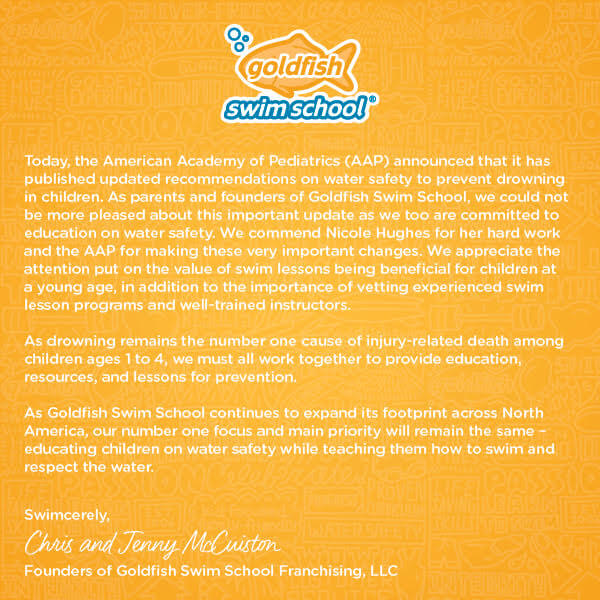Summer is just around the corner and as the temperatures start warming up, families will start taking frequent trips to the lake or beach, begin filling up the wading pool on the weekends, prepping the family pool for summer use, or go to the swimming pool together. Young children are very curious and are often fascinated by water without realizing that they could be in intimate danger. It is their curiosity that increases their chances of drowning.
Do you remember the little girl who snuck out while the babysitter wasn’t closely supervising the kids in the movie Beethoven? Drowning doesn’t discriminate and it can happen very quickly. Most children are unable to make noise once they fall into the water, even if it is only one or two inches deep. Never rely on listening for signs of drowning. Instead, they need constant supervision.

As parents, we all want to keep our children safe and prevent accidents before they happen. It only takes a few seconds for an accident to occur including drowning. Prevention is the best way to protect your child from drowning. So whether you own a pool, go to the beach or lake this summer, during bathtime, when little hands open the toilet bowl lid to play in the water, or while hanging out at the swimming pool, it is important to monitor your child carefully. Remember children are sneaky and they can get in trouble even if you take your eyes off them for a moment.
Use this checklist to help ensure that your child stays safe around water.
- Never leave young children alone or in the care of a young child near a pool, spa, wading pool, drainage ditch that often collects water after it rains, ponds, lakes, beaches, bathtub, or near standing water. Remember it only takes one to two inches for a young child to drown.
- Being swim lessons as soon as possible, even babies. The AAP whole heartedly recommends swim lessons starting at age one and even recommend taking lessons as a family. Swim lessons will teach your child the skills that they need in order to prevent drowning. If your child accidentally falls into the pool or other body of water, they are less likely to panic and remember to use the skills that they learn. Goldfish swim school is highly recommended and they offer swim lessons at an early age. All children and parents need to learn to swim. Everyone should complete a basic water competency swim class that includes skills that teach them how to enter the water, surface, turn around, propel oneself for at least 25 yards and then exit the water.
- Always access potential drowning risks in and around your home. Don’t forget about infant bath tubs or seats, toilets, buckets, or other containers filled with water.
- Anytime that your children is in or around a body of water, you need to pay close attention. Your attention needs to be constant and attentive. Avoid reading a book, using your phone, sun bathing, or doing other activities while keeping an eye on them.
- Install a four-sided fence around your swimming pool with a self-closing, self-latching gate to prevent the gate from accidentally being left open. Never prop the gate open even if you are closely watching your children. It only takes a few seconds for another child to sneak into the pool enclosure and drown. You want to keep the pool area separate from other areas of your yard that your children have access to use or play in.
- Parents, caregivers, and pool owners should take a CPR class and keep their certificate active. CPR can save a child’s life in the event of an accident. Always keep a telephone with service near the swimming pool so that you can call 911 promptly. It is best to use a landline phone and check to ensure that it is working on a weekly basis.
- Invest in pool safety equipment that is approved by the U.S. Coast Guard and keep it near the pool. This equipment needs to be replaced when it shows signs of wear and tear. Also, the equipment should never be used when there isn’t an emergency.
- Always keep U.S. Coast Guard approved life jackets for children, adolescents, and adults to use whenever they are in or board a watercraft. All adults should wear a life jacket too. It models safe boating behavior and may be necessary if a child needs assistance in the water or an emergency arises.
- Young children and non-swimmers should always wear a life jacket or approved flotation device such as a Puddle Jumper, when they are near water and while swimming, even with an adult close by.
Prevention can help prevent accidents from occurring. Drowning can happen very quickly and you won’t likely hear any screaming, most drownings are silent. Swim lessons are the best way to prevent your child from accidental drowning. They will be taught the skills necessary to help prevent them from drowning or panicing if they fall in.
As a member of the Goldfish Swim School community, we thought you would appreciate this update from the AAP and the following statement from Goldfish Founders Chris and Jenny McCuiston. Also, see the Goldfish Swim School team in Long Island on CBS News on this topic.
Yes it will be summer soon. These are great tips to keep in mind!